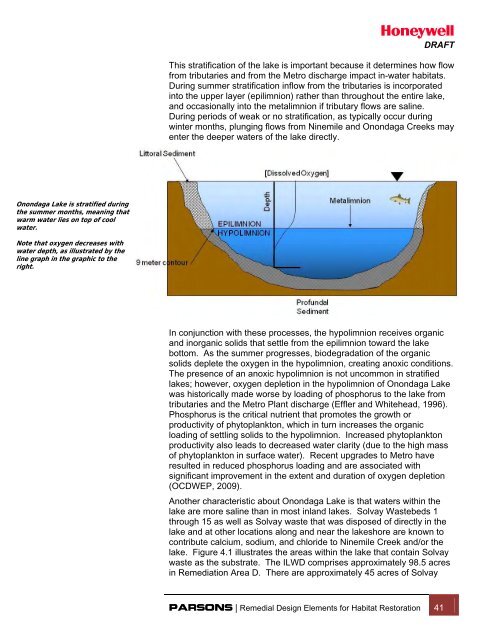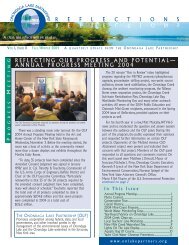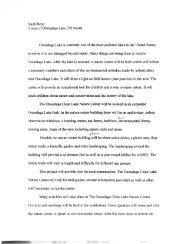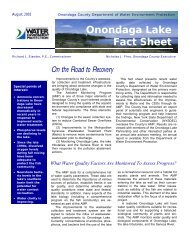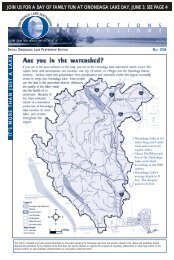Habitat Plan 2 - Onondaga Lake Partnership
Habitat Plan 2 - Onondaga Lake Partnership
Habitat Plan 2 - Onondaga Lake Partnership
You also want an ePaper? Increase the reach of your titles
YUMPU automatically turns print PDFs into web optimized ePapers that Google loves.
DRAFTThis stratification of the lake is important because it determines how flowfrom tributaries and from the Metro discharge impact in-water habitats.During summer stratification inflow from the tributaries is incorporatedinto the upper layer (epilimnion) rather than throughout the entire lake,and occasionally into the metalimnion if tributary flows are saline.During periods of weak or no stratification, as typically occur duringwinter months, plunging flows from Ninemile and <strong>Onondaga</strong> Creeks mayenter the deeper waters of the lake directly.<strong>Onondaga</strong> <strong>Lake</strong> is stratified duringthe summer months, meaning thatwarm water lies on top of coolwater.Note that oxygen decreases withwater depth, as illustrated by theline graph in the graphic to theright.In conjunction with these processes, the hypolimnion receives organicand inorganic solids that settle from the epilimnion toward the lakebottom. As the summer progresses, biodegradation of the organicsolids deplete the oxygen in the hypolimnion, creating anoxic conditions.The presence of an anoxic hypolimnion is not uncommon in stratifiedlakes; however, oxygen depletion in the hypolimnion of <strong>Onondaga</strong> <strong>Lake</strong>was historically made worse by loading of phosphorus to the lake fromtributaries and the Metro <strong>Plan</strong>t discharge (Effler and Whitehead, 1996).Phosphorus is the critical nutrient that promotes the growth orproductivity of phytoplankton, which in turn increases the organicloading of settling solids to the hypolimnion. Increased phytoplanktonproductivity also leads to decreased water clarity (due to the high massof phytoplankton in surface water). Recent upgrades to Metro haveresulted in reduced phosphorus loading and are associated withsignificant improvement in the extent and duration of oxygen depletion(OCDWEP, 2009).Another characteristic about <strong>Onondaga</strong> <strong>Lake</strong> is that waters within thelake are more saline than in most inland lakes. Solvay Wastebeds 1through 15 as well as Solvay waste that was disposed of directly in thelake and at other locations along and near the lakeshore are known tocontribute calcium, sodium, and chloride to Ninemile Creek and/or thelake. Figure 4.1 illustrates the areas within the lake that contain Solvaywaste as the substrate. The ILWD comprises approximately 98.5 acresin Remediation Area D. There are approximately 45 acres of SolvayPARSONS | Remedial Design Elements for <strong>Habitat</strong> Restoration 41


